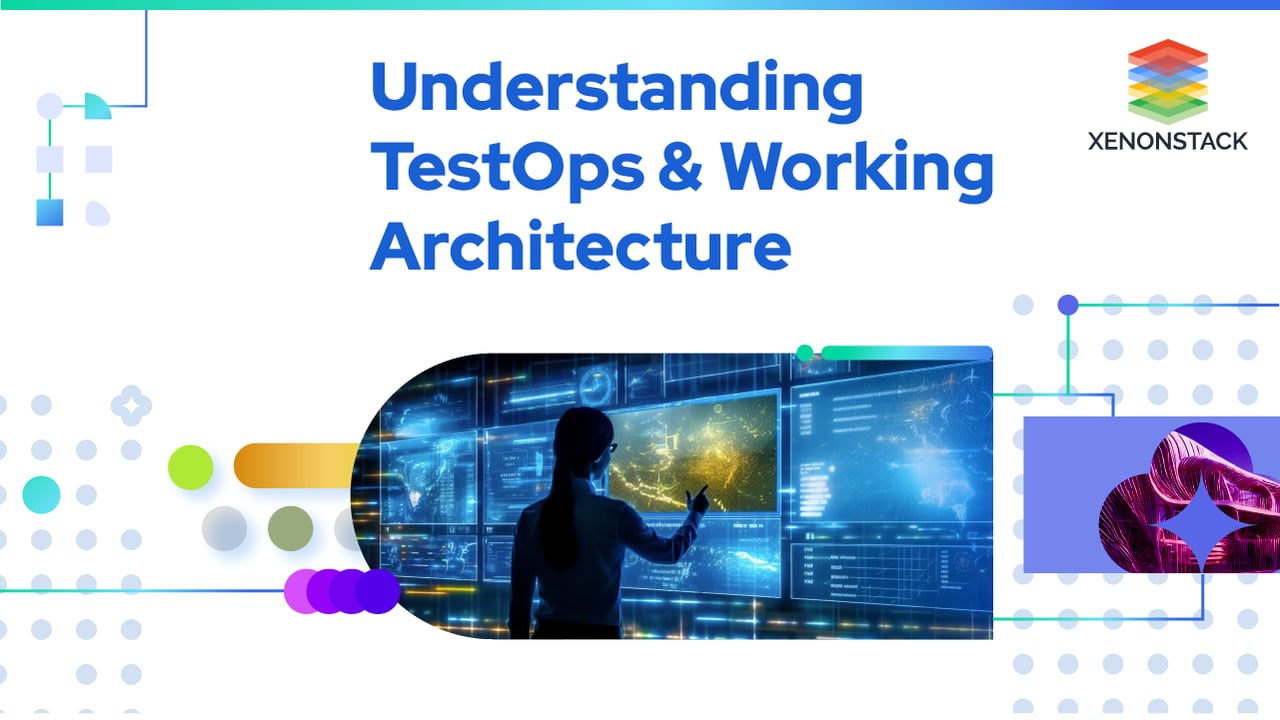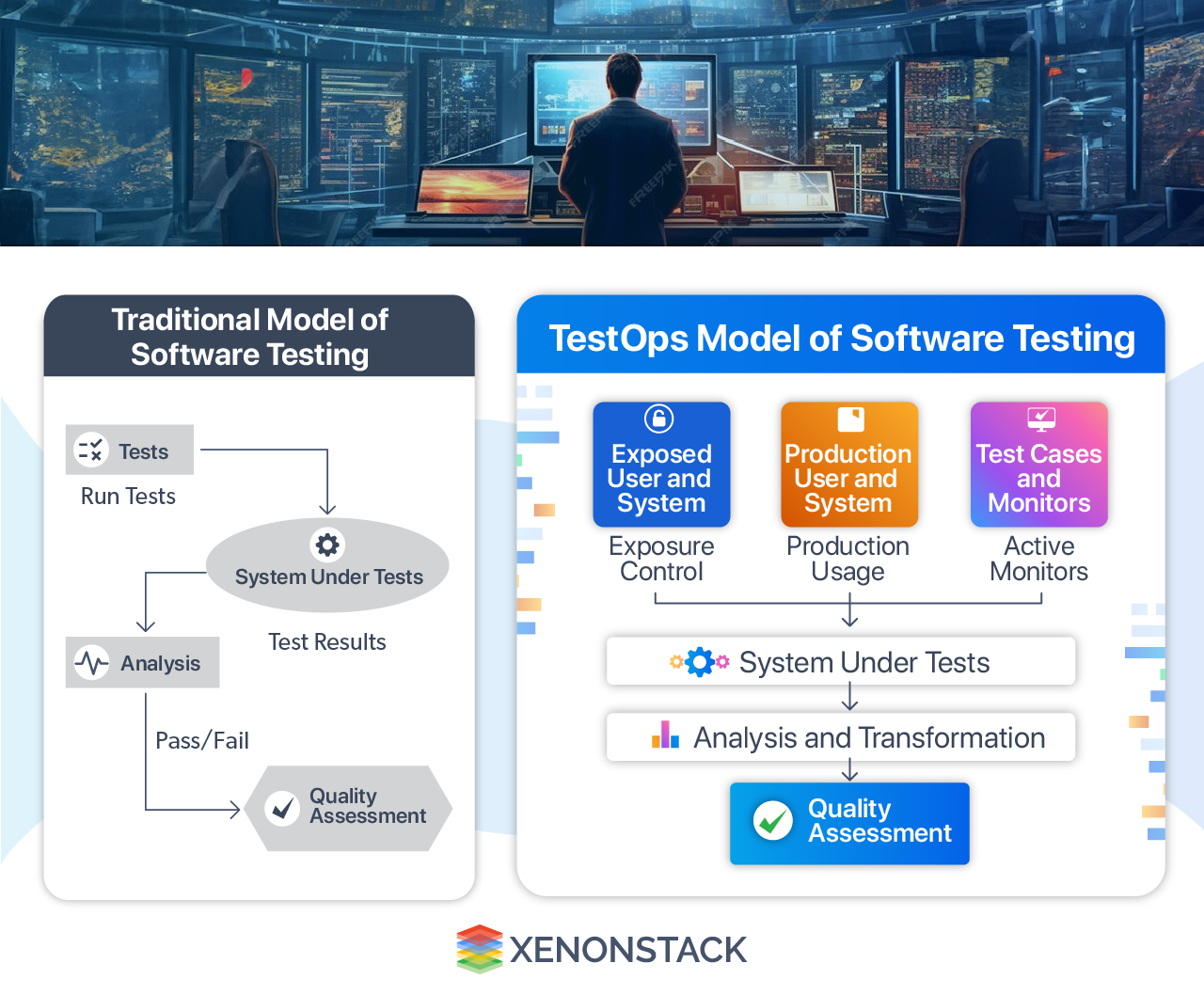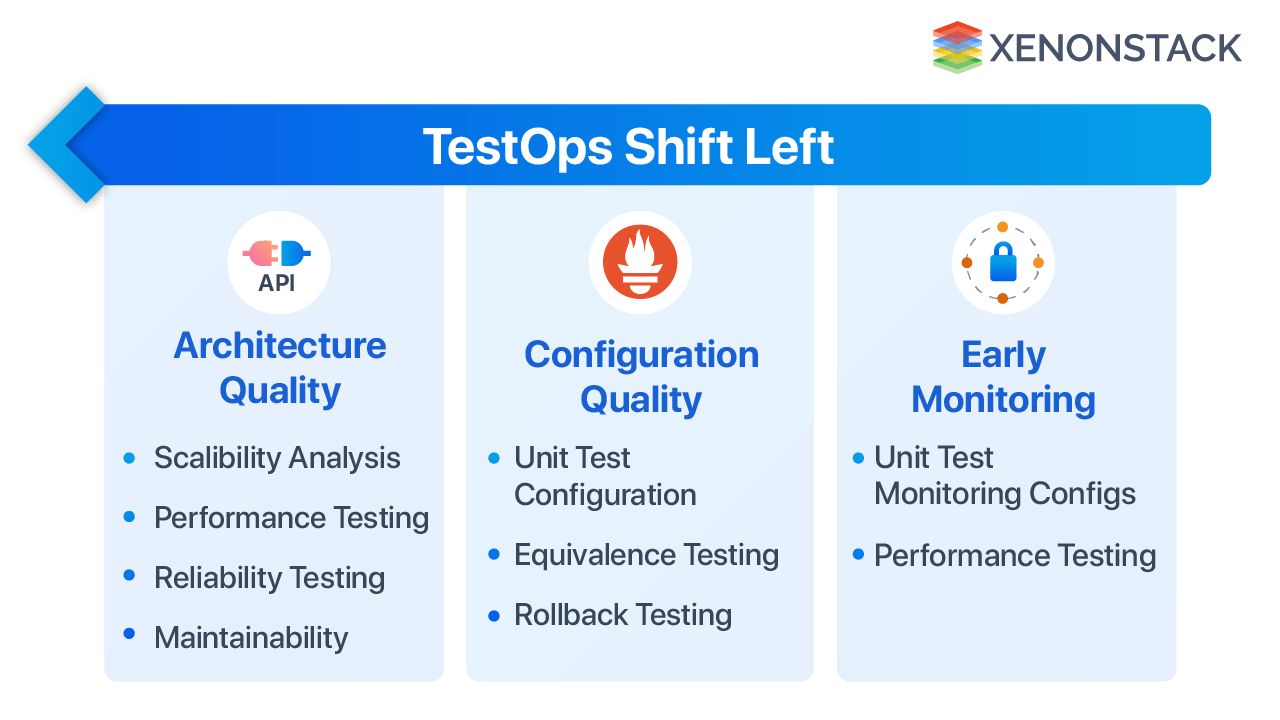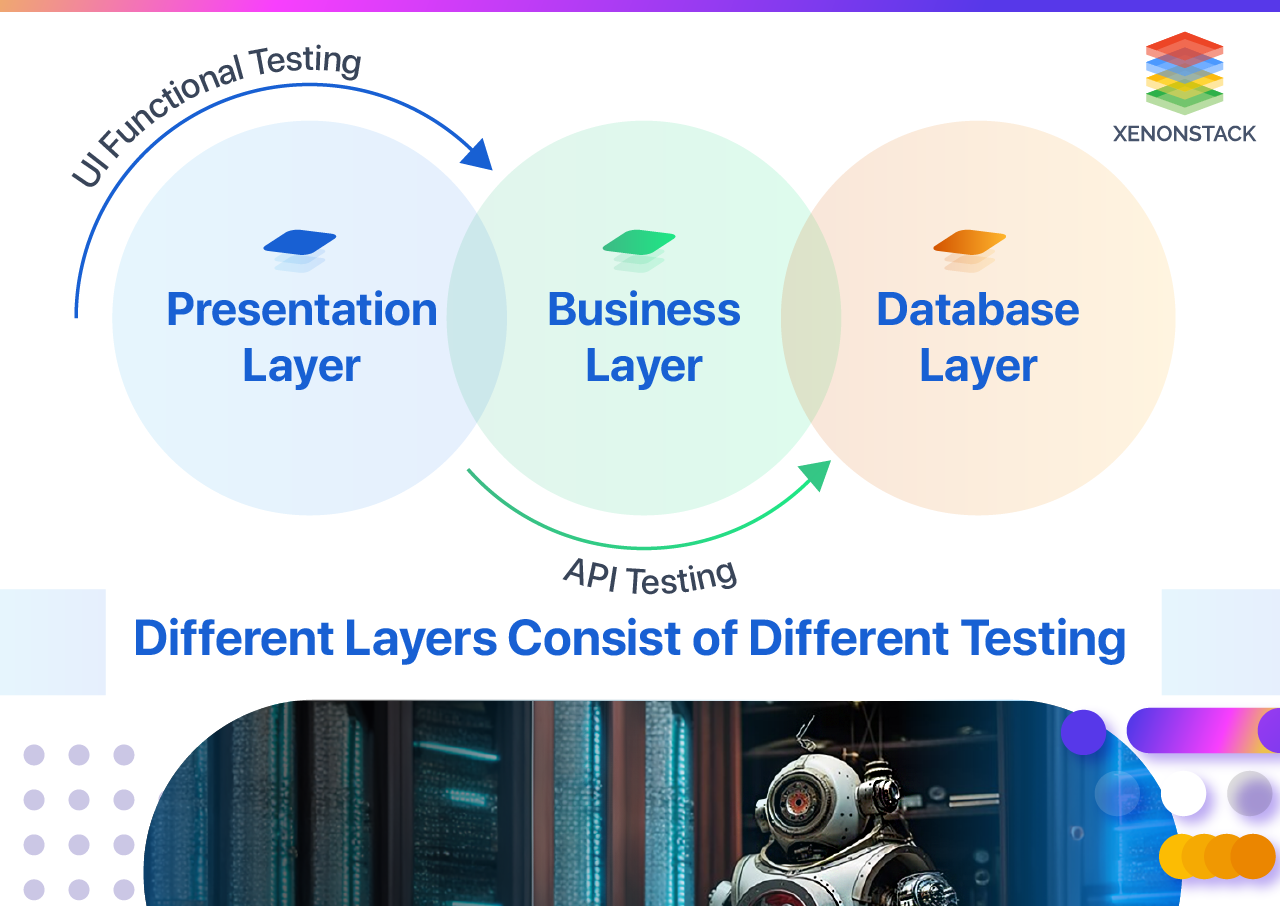
Introduction to TestOps
It is a rising technique to complete almost everyone's dream of watching Development, Operations, and Quality Assurance work together to discover more valuable and time-efficient products in the market. With a new channel like TestOps, one can reduce the development and testing time and enhance its quality in less period and effort.
At the CI/CD (Continuous Integration/ Continuous Delivery) time, the testing strategy must change to work accordingly with the Upgraded development and Integration. Let's look at its working and Strategy to know more about it.
What is TestOps?
It is the intellect to perform the primary QA job using DevOps actions to interact with the CI/CD working and build' continuous testing. Its term comes with well-known and in-use terms,' Test' and 'Operation.' Where test explains the role of testing the product with every built to perform functional, Non-functional, performance and all other types of testing, which is to be manually as well as automatically done for the products and operations to manage the Infrastructure management, security & compliances, database admin, Network technician, and other related tasks in the cycle.
According to it, the three teams, Dev, Ops, and QA, work together to achieve rigorous CI/CD testing. Parts of working for the three teams smoothly with its technique will take different steps & approaches. After working continuously with Test automation, one can provide the full structure and result to clients about the Testing and product validation in it to improve the working and process of QA using Test automation frameworks effectively.
How does it work?
To understand the figure below, remember that the three sections work together: continuous build, validation, and delivery. Continuous builds and validation are part of SDLC (Systems development life cycle). Here, the Test data in it for testing is collected from 3 different sources: exposure data, production systems, and test cases & monitors. This test data is necessary for the system under test to Analyze the build's performance.
Key Areas of Focus
-
Test data preparation to use in the System under test
-
Testing, which can be manual and automated, consists of main testing types as
-
Integration Testing
-
Automation Testing
-
Security Testing
-
'Transactional Testing' to check the transactions’ deviation from the regular and standard transactions.
-
Load testing for small builds and the whole system
-
Reliability testing to check the peak of the system failure possibility
CI/CD setup knowledge to prevent and resolve the issue while building deployment.png?width=1281&height=812&name=MicrosoftTeams-image%20(19).png)
The Significance of TestOps
-
As we are now working with manual and automation testing with different tools to make the testing process as fast as possible, we need to take a step forward with it to start testing in production. Previously, testing did not involve the Docker packs, but with it, engineers performed automated tests in Docker, collected results, and did the analysis.
-
The traditional testing cycle needs the fully developed module to test, but TestOps works with all the builds updated daily over the production environment.
-
Traditional testing is not enough to perform with CI/CD as the extra skills are required to acquire for Testing in CI/CD.
-
It encourages testing in production, which is not done in the Traditional testing cycle.
DevOps team helps in accelerating the processes. It is generally considered that the time to test a particular thing is high, and a big issue is delivering the product quickly and on time. Still, its approaches will be helpful for the team, especially the DevOps team, in releasing the processes quickly since they can parallelly deploy a testing environment with the DevOps build and deployment infrastructure. To confirm whether its functionality is working fine or not, the approach can be followed with high unit test coverage and a zero-bug policy.
-
The Evolution of its discipline
To make its discipline more effective and realize the organization's benefits, there is a need to evolve tester use cases, tools, techniques, collaboration patterns with people, and discipline associated with the application life cycle. There is a new trend related to its discipline, which many organizations use as a Shift-left approach.
TestOps Framework
TestOps is a framework that continuously tests and validates the software at all levels. The framework not only integrates the automated tests in the CI/CD Pipeline but also maintains the whole lifecycle of the product. TestOps framework can easily be combined with tools like Selenium, Docker, BrowserStack, and Jenkins to make the tests as robust as possible with low rate execution time. TestOps must detect failures early for the team to react and respond immediately.
Many organizations fail to deliver consistent quality to the customers with each application release. This is because the organization needs to ensure the test coverage of the continuous application releases. Small teams provide complete test coverage by picking the right tool for automation and working closely with the development and operations teams. But for larger teams, it gets pretty challenging to maintain track of the test coverage because larger teams heavily focus on the automation processes, frameworks, and tools and run them with CI/ CD integrating with pipelines to get the in-depth visibility of the test operations and generating reports which can be analyzed later.
How does the process work?
Below listed are the process
What is its Architecture?
It refers to using the QA automation approach to monitor the real-time performance of the production environment. The three teams' development, Operation, and QA work together to achieve the CI/CD discipline. Following the automation testing approach can increase reliability and customer satisfaction and improve the working of processes. How does it work?
The OP's task of monitoring the process and product quality and performing continuous testing to achieve high customer satisfaction is now added to the tester's skill set. It ensures the quality is kept while mixing the Dev and Ops test parts.
It includes the following points.
-
Preparation of Test Data to use in Testing.
-
Testing includes the following following types:
-
Integration Testing
-
Automation Testing
-
Security Testing
-
Performance Testing
-
Accessibility Testing
-
CI/CD knowledge to validate the processes going on.
What are the critical elements involved in TestOps?
Four components come under TestOps Discipline
- Planning
Planning is done in the early phase of the development cycle, and planning is the ongoing process for rapid changes that occur in development. Planning helps the team set the task's priorities, code complexity, and test coverage. It helps in determining what to automate and what to test manually. The product and the business owner, development team, and testing team make plans together and, according to decided plans, make a document to help team alignment.
-
Control
Control refers to monitoring all the tasks and controlling the process flow. A small team can believe in any agreement and document, whereas a larger team needs processes. Testing subject matters can guide the team to reuse the existing testing component.
-
Management
Management refers to how the higher authority and the team organize all the processes and tasks in a well-defined manner. It can include dividing the task among team members and setting priorities, naming conventions, and determining how the test cases are organized in the test suites.
-
Insights
Insight refers to the information gathered from testing and helps teams better understand product quality and team effectiveness. Instead of the operational side, the testing team's team leader must also carefully visualize the potential process improvements.
What skills are essential for success in TestOps?
-
Average testing skills are not enough to work with it. Here, we will see some of the necessary skills you might get into working with the requirements of operational activities, such as configuration details, alarms, failures, networks, and much more.
-
Good knowledge of JavaScript and Python to write the test script.
-
Testing functional skills will not work, but non-functional and tool knowledge is also essential.
-
Collect good understanding and research data-sharing methods like REST, WebSocket, and more.
-
Operating systems knowledge and scripting over the entire OS are essential.
-
Understanding working with different integration tools, such as Jenkins, Bamboo, and more, is mandatory to get the most output from the tests.
Automation skills must be over-grilled, as it requires quick testing.
What are its key features?
The critical features of TestOps are listed below:
Test Coverage and a Zero Bug PolicyTo ensure that the functionality is working as expected, the unit test policy makes it evident that each functionality is thoroughly tested and no problems arise at the build time. This enables me to focus more on writing better code. The zero-bug policy resolves the bug raised during production at any point during a team sprint. It must be evaluated and either worked on or closed if deemed not customer-impacting, and the reason must be explained.
Continuous Integration and Frameworks
The developer pushes the code, and it is compiled. The CI keeps track of any new code being committed to the repositories with the assistance of triggers.
Speed of Delivery vs. Quality
A classic problem the tester faces is maintaining the speed of delivery with high-quality standards. As the competition is rising, no tech company would want downtime in their service and always wants the users to use their service with zero downtime. Even if the system is downtime, they should always be prepared to return the service.
Nowadays, faster delivery wants faster testing of the particular feature. Test automation should be carried out in the pipeline so that the regression tests can find the defects in the software.
What are the types of Testings covered in it?
The Customer expects that the product, built by a particular organization, should support multiple platforms. Most customers have different clients- Mobile, Web, and API.
So that we can make our test truly integrational.
-
Mobile Testing
Mobile device testing refers to the testing in which mobile applications are tested for functionality, usability, and consistency. Mobile application Testing can be done manually and with an automation approach.
Web Application Testing
Web Testing is a software testing principle that helps ensure web applications' quality, performance, and functionalities and ensures that the actual outcome is according to the expected result. Web application testing detects functional security breaches, Integration problems, and network traffic issues before the product is delivered.
1. API Testing
API Testing is the software testing type that tests the API for functionality, security, reliability, and performance. API Testing is done at the business layer, where business processes and all the interactions between the database and user interface layers are carried out.
2. What are the best tools?
As TestOps is the rising technique which takes time to come under use all over, and a lot more tools are going to come into existence in the future-
3. Katalon TestOps (Beta)
It is an emerging product that applies continuous test execution and analytics to integrate the products with better quality. This tool provides cloud-based services to test and integrate simultaneously. It also supports native CI as Bamboo, Jenkins, CircleCI, and Azure DevOps to offer a wide range of options. Here are some insights into the tool.
4. TestOps Center
It provides a center to collect quality data from different sources and provide analytics for the project. It can also get test execution key points integrated with other tools such as Jira and other devices.
5. TestOps CI
It handles the test environments and the schedule of remote executions with tools like Jira.
6. Vision TestOps
Its vision is based on AI to detect the bugs in applications and tools.
7. TestOps Reports
This handles and generates reports of all types of test executions and changes to get an insight into the results.
8. TestOps With CI/CD Approach
-
It works with three approaches simultaneously, which are continuous development, continuous validation, and continuous delivery. Constant building and continuous Testing are associated with the software development life cycle. It focuses on the product's productive and effective development and successful delivery. Developers write the code for each functionality and push the code to the repository, and after every sprint, the code is compiled. The CI validates the code that is in the repository.
-
Continuous Validation works with the approach to testing that focuses on processes and tools being implemented. Unit testing is performed on the code to verify that the code should be bug-free. Continuous Delivery confirms that the code is running correctly with the latest changes, and the product should be bug-free.
TestOps with DevOps
1. DevOps collaborates between Development and Operation to reduce the difference between the two. DevOps terms simplify and ease the deployment of high-quality and complex code faster and easier. Normally, the DevOps cycle follows the development of code steps and the integration of binaries into testing environments and test cases. Deploy after QA approval for the bug-free application. But with it, the process changes and steps will be like.
-
Continuous Build
-
CI (Continuous Integration)
-
Continuous Validation
2. It is an excellent chance for QA in DevOps testing. If we talk about DevOps, the quality check is complicated when working for automated pipelines, which increases the testing because the complicated applications have multiple checkpoints, interrelated services, and many more to get verified and validated for testing.
What are its Best Practices?
-
Knowledge of different tool integrations with CI is essential for testing.
-
More Test automation needs to be practiced for testing.
-
Always Practice multi-layer testing.
-
With all testing, take performance testing also in the Delivery cycle.
-
Don't waste necessary time on extra and unused executions.
-
Do a strict use of Containerization.
-
Track your execution matrix to get the latest result sets from the execution.
-
What are its features of it
-
At every build, the commit tester should know what to test for that build.
-
Fix every bug at the primitive level.
-
Simple Integration with DevOps.
TestOps’s focus area
Real-time dashboards
The test results created by the real-time dashboards help the team with the test execution reports and can be shared among the other team members. The execution reports give visibility into the key test metrics and help improve the process/tests if required.
Cloud-based Automation Testing
Setting up the environment where we will conduct the testing takes a lot of effort and time. The most effective way to set up these environments is to approach Cloud-based Automation solutions, thereby reducing the initial cost required for the infrastructure.
Non-functional testing is essential.
Testing the functional components of the application does not ensure that it will perform at its best. Carrying out non-functional testing ensures the system’s reliability and performance and sustains the load of the users beyond its capacity.
Mobile App Testing
Mobile app testing guarantees the testers the quality of the app developed and defect-free. With frequent releases of the app builds, the TestOps framework can help in continuous testing.API Testing
Testers perform tests on API to find vulnerabilities and security breaches in the API as the API holds sensitive data. Any security breach for an API can be costly. Thus, testers ensure the response time, response body, and several requests the API can handle.
Conclusion
There are no words because there's much to know about TestOps now and in the future. It is the rising technique for testers and a revolution in testing continuously by covering all end-points of Continuous Integration & development. To adopt it, testers need to enhance their skill level for the testing concepts and the Integration and deployment of continuous builds. This methodology fastens the build validation and supports the testing in production.
- Discover more about Software Testability Metrics
- Click to explore Design Patterns in Automation Testing
.webp?width=1921&height=622&name=usecase-banner%20(1).webp)


